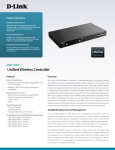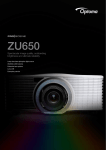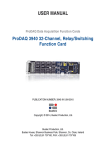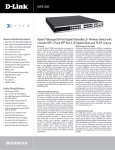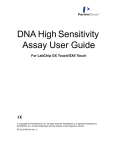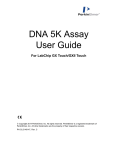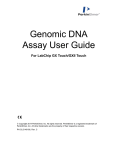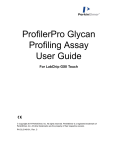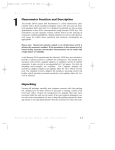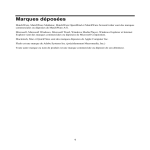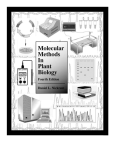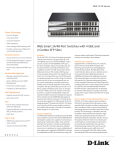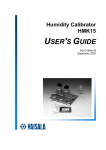Download HT Protein Express LabChip Kit, Version 2 LabChip GXII User Guide
Transcript
HT Protein Express LabChip® Kit, Version 2 LabChip GXII User Guide Contents Specifications 2 Sample Conditions Kit Contents 2 3 Preparation Procedure 5 Additional Items Required Preparing the Gel-Dye and Gel Destaining Solutions Preparing the Sample Denaturing Solutions Preparing the Protein Samples and Ladder Preparing the Buffer Tube Preparing the Protein Chip Inserting a Chip into the LabChip GX Instrument Running the HT Protein Express Assay Storing the Protein Chip Chip Cartridge Cleaning 5 5 5 6 6 7 8 8 9 9 Typical Results 10 Troubleshooting 11 LabChip Kit Essential Practices 16 General Reagents Chips Samples Protein Assay Buffer, Salt and Additive Compatibility Chip Well Aspiration Using a Vacuum 16 17 17 18 19 20 Reordering Information 21 Customer Technical Support 21 Caliper Life Sciences 68 Elm Street Hopkinton, MA 01748-1668 1-877-LABCHIP (522-2447) Page 1 of 21 Revised Nov 2010 HT Protein Express LabChip® Kit, Version 2 LabChip GXII User Guide Specifications P100 Assay: 14 kDa – 100 kDa P200 Assay: 14 kDa – 200 kDa Sizing Range 1 Sizing Resolution ± 10% difference in molecular weight Sizing Accuracy ± 20% Linear Concentration Range 5.0 – 2000 ng/µL Maximum Total Protein Concentration 10 mg/mL Quantitation Reproducibility 30% CV up to 120 kDa. Above 120 kDa, quantitation is not specified. Chip Lifetime2 400 samples (four 96-well plates or one 384-well plate) Sample Capacity per Chip Prep 400 samples (four 96-well plates or one 384-well plate) Sample Conditions Buffers, Salts and Additives Please refer to the list “Protein Assay Buffer, Salt and Additive Compatibility" in the rear of the guide for compatibility with specific buffers, salts and additives. If your conditions are not listed, please contact Caliper Life Sciences at 1-877-LABCHIP for more information on compatibility. Particulates Sample plates should be spun down prior to analysis. All buffers should be filtered with a 0.22 μm cellulose acetate filter. Salt Concentration 1 2 Total salt concentration must not exceed 1M. Resolution is defined as the height of the valley between two peaks to be no more than 50% of the maximum peak height. Actual separation performance can depend on the sample and application. Expected chip lifetime is based on use under normal laboratory conditions and adherence to Caliper preparation protocols, sample guidelines and storage conditions. Individual laboratory results may vary. Caliper Life Sciences 68 Elm Street Hopkinton, MA 01748-1668 1-877-LABCHIP (522-2447) Page 2 of 21 Revised Nov 2010 HT Protein Express LabChip® Kit, Version 2 LabChip GXII User Guide HT Protein Express Reagent Kit - Part Number 760328 Item Vial Quantity Protein Dye Solution Blue 1 vial of 0.090 mL Sample Buffer White 2 vials, 1.4 mL each Red 2 vials, 1.8 mL each Protein Gel Matrix Protein Ladder Yellow 1 vial, 0.08 mL Lower Marker Green 1 vial, 0.5 mL Wash Buffer Purple 4 vials, 1.8 mL each Spin Filters — 8 spin filters HT Protein Express LabChip Kit, Version 2 - Part Number 760431 Protein Chip — 1 Ladder Tubes — 10, 0.2 mL PCR tubes Centrifuge Tubes — 5, 2.0 mL centrifuge tubes Detection Window Cleaning Cloth — 1 clean room cloth Swab — 3 Buffer Tubes — 10, 0.75 mL tubes HT Protein Express Reagent Kit — 1 Caliper Life Sciences 68 Elm Street Hopkinton, MA 01748-1668 1-877-LABCHIP (522-2447) Page 3 of 21 Revised Nov 2010 HT Protein Express LabChip® Kit, Version 2 LabChip GXII User Guide Safety Warnings and Precautions ! WARNING ! For Research Use Only. Not recommended or intended for diagnosis of disease in humans or animals. Do not use internally or externally in humans or animals. CAUTION We recommend that this product and components be handled only by those who have been trained in laboratory techniques and that it is used in accordance with the principles of good laboratory practice. As all chemicals should be considered as potentially hazardous, it is advisable when handling chemical reagents to wear suitable protective clothing, such as laboratory overalls, safety glasses, and gloves. Care should be taken to avoid contact with skin or eyes. In case of contact with skin or eyes, wash immediately with water. ! WARNING ! Dye Solution contains DMSO. Avoid contact with skin and eyes. ! WARNING ! Dye Solution contains SDS. Avoid inhalation and contact with skin and eyes. ! WARNING ! Wash Buffer and Sample Buffer contain LDS. Avoid inhalation and contact with skin and eyes. ! WARNING ! Gel Matrix contains Methylurea. Avoid contact with skin and eyes. Storage: Prior to use, store chips and reagents refrigerated at 4 °C. After use leave chips at room temperature for up to 30 days. Caliper Life Sciences 68 Elm Street Hopkinton, MA 01748-1668 1-877-LABCHIP (522-2447) Page 4 of 21 Revised Nov 2010 HT Protein Express LabChip® Kit, Version 2 LabChip GXII User Guide Preparation Procedures Additional Items Required • 0.6 mL centrifuge tubes and/or 96-well plates for denaturing protein samples Note: Avoid using non-stick varieties of lab consumables. These may induce unexpected or erratic assay results caused by surface treatments leaching into dye or gel components. • • • MilliQ Water: Molecular biology grade or better, 0.22-micron filtered. 70%-isopropanol solution in DI water. Reducing agents: BME (beta-mercaptoethanol), 1M DTT (dithiothreitol) or 100mM TCEP. Note: Allow the chip and all reagents to equilibrate to room temperature before use (approximately 20 to 30 minutes). Preparing the Gel-Dye and Gel Destaining Solutions Note: The Dye Solution contains DMSO and must be thawed completely before use. Note: Do not exceed 9300 rcf when filtering gel and Gel-Dye solutions. Exceeding 9300 rcf will change the properties of the gel. 1. Gently vortex the thawed Dye Solution for 10 seconds before transferring. 2. Transfer 20 µL of HT Protein Express Dye Solution (blue cap) to the 2.0 mL centrifuge tube provided with the reagent kit. Add 520 µL of the HT Protein Express Gel Matrix (red cap) using a Reverse Pipetting Technique. 3. Vortex the solution until it is well mixed . 4. Transfer the solution into one of the spin filters provided with the reagent kit. 5. Transfer 250 µL of the HT Protein Express Gel Matrix (red cap) into a separate spin filter. This will be used as the Destain solution. 6. Centrifuge the solutions in both spin filters at 9300 rcf for 5 minutes at RT. Remove the filters in the tubes and store in the dark until the chip is to be prepared. 7. The volumes of Gel-Dye and Destain solutions prepared are the required amount for one chip prep. If you are preparing additional solution for future use, store the remaining solutions in the dark at 4 °C and use within 3 weeks. Preparing the Sample Denaturing Solution 1. Pipette 700 µL of HT Protein Express Sample Buffer (white cap) into a 2.0 mL centrifuge vial. 2. If samples need to be reduced, add 24.5 µL of BME or DTT or 3.75 µL of 100 mM TCEP. 3. Vortex for 10 seconds. This volume of sample buffer and reducing agent is sufficient to prepare 96 samples. Caliper Life Sciences 68 Elm Street Hopkinton, MA 01748-1668 1-877-LABCHIP (522-2447) Page 5 of 21 Revised Nov 2010 HT Protein Express LabChip® Kit, Version 2 LabChip GXII User Guide Preparing the Protein Samples and Ladder Note: Samples can be prepared in either a 96-well or 384-well plate or in 0.6 mL microcentrifuge tubes (and subsequently pipetted into a plate). Procedures for both are described here. 1. For each sample to be analyzed, pipette 7 µL of denaturing solution into the wells of a microtiter plate or into individual 0.6 mL microcentrifuge tubes. 2. Pipette 2 µL of each protein sample into the wells of the 96-well plate or microcentrifuge tube. When finished, cover the plate with foil to minimize evaporation. (If running the High Sensitivity Assay, pipette 5 µL of each protein sample.) 3. Allow the HT Protein Express Ladder to warm up to room temperature for 15-20 minutes followed by vortexing for 10 seconds. Pipette 12 µL of HT Protein Express Ladder into a microcentrifuge tube. Do not add denaturing solution to the ladder. 4. Denature samples and ladder at 100°C for 5 minutes. Optimum denaturing conditions may vary by sample type. 5. Tap or spin the sample plate to move the fluid to the bottom of the wells. 6. Spin the HT Protein Express Ladder (and sample tubes if used) for 15 seconds using a mini-centrifuge. 7. Add 120 µL of water to the HT Protein Express Ladder. Vortex the ladder mixture for a few seconds to achieve good mixing. 8. Add 35 µL of water to each sample well or sample tube. This step should not be done more than an hour before starting the assay. (If running High Sensitivity scripts, add 32 µL of water to each sample well or sample tube.) Vortex the sample tubes (if used) for a few seconds. If using a plate, a pipettor or plate shaker can be used to mix the water with the samples. 9. If the samples are prepared in tubes, load 44 µL of each sample onto a 96-well plate. 10. Spin the sample plate to eliminate bubbles and move the fluid to the bottom of the wells. 11. Place the sample plate onto the instrument’s plate holder. 12. Transfer 120 µL prepared ladder to the provided 0.2 mL Ladder Tube. 13. Insert the Ladder Tube into ladder slot on the LabChip GX instrument. Preparing the Buffer Tube 1. Add 750 µL of HT Protein Express Wash Buffer (purple cap) to the 0.75 mL Buffer Tube provided with the reagent kit. 2. Insert the Buffer Tube into the buffer slot on the LabChip GX instrument. Note: Replace the Buffer Tube with a freshly prepared Tube every 8 hours when the chip and instrument are in use. Caliper Life Sciences 68 Elm Street Hopkinton, MA 01748-1668 1-877-LABCHIP (522-2447) Page 6 of 21 Revised Nov 2010 HT Protein Express LabChip® Kit, Version 2 LabChip GXII User Guide Preparing the Protein Chip 1. Allow the chip to come to room temperature and remove foil cover from chip wells. 2. Use a pipette tip attached to a vacuum line to dry the top and bottom chip surfaces and the top of the chip container. DO NOT run the tip over the central region of the detection window. Return the chip to the chip container when the bottom of the chip and the top of the chip container are dry. 3. Thoroughly aspirate all fluid from the chip wells using a vacuum line with the chip placed in the container and the sipper immersed in fluid. 4. Each active chip well (1, 2, 3, 4, 7, 8, 9 and 10) should be rinsed and completely aspirated twice, with molecular biology grade .Using a vacuum to aspirate the chip wells is more effective than using a pipette. See page 20 for more details. water. Do not allow active wells to remain dry. 5. Add 75 µL of Gel-Dye solution to chip wells 3, 7, 8 and 120 µL to well 10 using a Reverse Pipetting Technique. 6. Reagent Placement Add 75 µL of Destain solution to chip wells 2 and 9 using a Reverse Pipetting Technique. 7. If the chip will be used to analyze multiple 96-well plates or will be in use for up to 8 hours, add 120 µL of HT Protein Express Lower Marker (green cap) to chip well 4. If the chip will only be used to analyze one 96-well plate or a partial plate and then stored for future use, the marker volume can be reduced to 40 µL. Make sure the marker volume is pipetted accurately. If there is not enough marker in chip well 4, the marker will deplete prior to the completion of the plate. Data collected without marker peaks cannot be analyzed by the software. 8. Make sure the rims of the chip wells are free of adhesive residue. 9. Place the chip in the LabChip GX instrument to begin the assay. Note: Be sure to periodically clean the O-rings on the top plate of the chip interface on the LabChip GX instrument. Use the provided lint free swab dampened with DI water or 70%-isopropanol solution in DI water to clean the Orings, using a circular motion. Allow the O-rings to dry before inserting a chip. Caliper Life Sciences 68 Elm Street Hopkinton, MA 01748-1668 1-877-LABCHIP (522-2447) Page 7 of 21 Add Marker, Gel-Dye and Destain according to the image above. Revised Nov 2010 HT Protein Express LabChip® Kit, Version 2 LabChip GXII User Guide Inserting a Chip into the LabChip GX Instrument 1. Check that the sample plate, Buffer Tube, Sample Well A1 and Ladder Tube are placed appropriately on the instrument. 2. Remove the chip from the chip storage container and inspect the chip window. Clean BOTH sides of the chip window with Ladder Tube the Caliper-supplied cleanroom cloth dampened with a 70%-isopropanol solution Buffer Tube in DI water. 3. Eject the chip cartridge by pressing the CHIP button on the instrument front panel. 4. Release the cartridge latch, insert the chip into the LabChip GX instrument, refasten the latch and push the cartridge into the instrument. 5. Press the EJECT button on the instrument front panel to retract the sample plate and send the sipper to the Buffer Tube. Running the HT Protein Express Assay 1. Start the LabChip GX software. 2. On the main screen, click on the Run button in the upper left corner of the LabChip GX Software. 3. The Start Run dialog box will pop up with tabs listed as Output, Run and Advanced. 4. In the Run Tab, select the appropriate assay type, operator name, plate name, well pattern and barcode option. • For HT Protein Express assays appropriate assay types are: o o HT Protein Express 100: For sizing of protein in 14kDa to 100 kDa range. HT Protein Express 100 High Sensitivity: For sizing of protein in 14kDa to 100 kDa range. Greater sensitivity but requires a larger amount of sample. Slightly lower resolution may be observed. o o HT Protein Express 200: For sizing of protein in 14kDa to 200 kDa range. HT Protein Express 200 High Sensitivity: For sizing of protein in 14kDa to 200 kDa range. Greater sensitivity but requires a larger amount of sample. Slightly lower resolution may be observed. 5. In the Output Tab select the destination of the file, the filename convention and any additional data to 6. In the Advanced Tab select the number of times each well is sampled, the inclusion of any sample names autoexport. and any expected peaks. 7. Click Start to begin the run. Caliper Life Sciences 68 Elm Street Hopkinton, MA 01748-1668 1-877-LABCHIP (522-2447) Page 8 of 21 Revised Nov 2010 HT Protein Express LabChip® Kit, Version 2 LabChip GXII User Guide Storing the Protein Chip After use, the chip must be cleaned and stored in the chip container. 1. Remove the reagents from each well of the chip using vacuum. 2. Each active well (1, 2, 3, 4, 7, 8, 9 and 10) should be rinsed and aspirated twice molecular biology grade water. 3. Add 120 µL molecular biology grade water to the active wells. 4. Place the chip in the plastic storage container. The sipper should be submerged in the fluid reservoir. 5. Cover the wells with parafilm to prevent buffer evaporation and store the chip at room temperature until next use. The chip must be used to its lifetime (three 96-well plates) within 30 days of analyzing the first plate of samples. Chip Cartridge Cleaning 1. Daily A) Inspect the inside of the chip cartridge and O-rings for debris. B) Use the provided lint free swab dampened with DI water or 70%-isopropanol solution in DI water to clean the O-rings using a circular motion. If the O-rings stick to the chip or a pressure leak is detected, perform the more extensive monthly cleaning procedure. 2. Monthly A) To reduce pressure leaks at the chip interface, clean the O-rings frequently. Remove the O-rings from the top plate of the chip interface on the LabChip GX instrument. Soak O-rings in DI water for a few minutes. Clean the O-ring faces by rubbing between two fingers. B) To reduce the occurrence of current leaks, clean the chip interface frequently. Clean the top plate of the chip interface using the provided lint free swab dampened with DI water. C) Allow the O-rings and chip interface to air dry. Reinsert the O-rings into the chip cartridge. Caliper Life Sciences 68 Elm Street Hopkinton, MA 01748-1668 1-877-LABCHIP (522-2447) Page 9 of 21 Revised Nov 2010 HT Protein Express LabChip® Kit, Version 2 LabChip GXII User Guide Results HT Protein Express Ladder Result The electropherogram of a typical Protein Express ladder is shown below. Peaks to the right of the lower marker and system peaks in order of increasing migration time correspond to proteins of increasing size i.e. 15.9 kDa, 20.4 kDa, 28.9 kDa, 48.4 kDa, 68.4 kDa and 119.2 kDa respectively. Lower Marker System Peak Caliper Life Sciences 68 Elm Street Hopkinton, MA 01748-1668 1-877-LABCHIP (522-2447) Page 10 of 21 Revised Nov 2010 HT Protein Express LabChip® Kit, Version 2 LabChip GXII User Guide Troubleshooting 1. Symptom: Missing sample AND marker peaks. Possible causes: A) Clog in sipper or marker channel of chip. What to do: A) Reprime the chip. See the section entitled “LabChip Kit Essential Practices – Chips” for instructions on how to reprime the chip. 2. Symptom: Ladder detected but no sample peaks. Possible causes: A) The sipper is not reaching the sample due to low sample volume in the well plate. B) If the missing sample peaks occurred only in a few wells of the plate, check those wells for air bubbles. C) The sipper is not reaching the sample due to an incorrect capillary height setting. D) If the plate has been uncovered for some time, sample evaporation might have occurred. E) Debris from the sample or sample prep is clogging the sipper. What to do: A) Add more sample to the well. Recommended sample volume is 44 μL. B) Manually insert a larger volume pipette tip (~100 µL) into the sample well and dislodge the bubble. Rerun these sample wells. C) Re-teach the robot positioning as described in LabChip GX Users Manual. D) Check the sample wells, especially around the edge of the plate where evaporation is fastest, and make a fresh plate if volumes are low. E) If you suspect there may be debris in your samples, spin the sample plate down in a centrifuge. Unclog the sipper by repriming the chip. See the section entitled “LabChip Kit Essential Practices – Chips” for instructions on how to reprime the chip. Caliper Life Sciences 68 Elm Street Hopkinton, MA 01748-1668 1-877-LABCHIP (522-2447) Page 11 of 21 Revised Nov 2010 HT Protein Express LabChip® Kit, Version 2 LabChip GXII User Guide 3. Symptom: No ladder peaks but sample peaks and marker peaks are present. Possible causes: A) Low or no ladder volume in Ladder Tube. What to do: A) Add more ladder to the Ladder Tube and restart the run. Recommended standard ladder volume is 120 μL (minimum volume no less than 100 μL). 4. Symptom: Hump in several electropherograms which do not correspond to sample data. 1250 750 500 20 30 35 40 45 Time (seconds) 11 10 9 8 7 2 3 4 25 6 0 5 LM 250 1* Fluorescence 1000 50 55 60 Possible causes: A) Electrode 7 is dirty and has contaminated the Gel-Dye mixture in well 7. B) High concentrations of detergent in the sample buffer can sometimes cause humps in the electropherogram at lower molecular weights (approximately 6 – 20 kDa). What to do: A) Remove the chip and follow the electrode cleaning procedure. We also recommend using the provided swab and isopropanol to manually clean electrode 7. Before restarting the run, lower the detergent concentration in the sample (see table for compatibility of buffers and detergents) Caliper Life Sciences 68 Elm Street Hopkinton, MA 01748-1668 1-877-LABCHIP (522-2447) Page 12 of 21 Revised Nov 2010 HT Protein Express LabChip® Kit, Version 2 LabChip GXII User Guide 5. Symptom: High baseline fluorescence (for example – greater then 1000 counts) Possible causes: A) The destain wells (2 and 9) do not contain Destain solution (gel matrix with no dye). B) The destain wells (2 and 9) may have been contaminated with dye either because the well was improperly flushed after priming or because dye was mistakenly pipetted into the well. What to do: A) Prepare a fresh Destain solution. Wash and reprime the chip with the new Destain solution. See the section entitled “LabChip Kit Essential Practices – Chips” for instructions on how to wash and reprime the chip. B) See A) 6. Symptom: Lower signal for ladders and samples than expected. Possible causes: A) Improper SDS concentration in Gel-Dye matrix. What to do: A) Ensure that Dye Concentrate is completely thawed and mixed. Ensure proper dispense of viscous gel into the Gel-Dye mixture, e.g. use a Reverse Pipetting Technique, or use a direct displacement pipette. Prepare a fresh Gel-Dye solution. Wash and reprime the chip with the new Gel-Dye mixture. See the section entitled “LabChip Kit Essential Practices – Chips” for instructions on how to wash and reprime the chip. 7. Symptom: No marker peaks but sample peaks are present. Possible causes: A) No marker added to chip well 4. B) If there is marker solution in chip well 4, the problem may be due to a marker channel clog. What to do: A) This may be due to not filling marker well or chip remaining idle on instrument for extended period of time. Add or replenish the marker solution in the chip using the following procedure: • Press the CHIP button on the front instrument panel to eject the chip cartridge. Open the chip cartridge and return the chip to the chip container ensuring the sipper is immersed in fluid. • Thoroughly aspirate all fluid from chip well 4 using a vacuum line. • Ensure that chip well 4 is rinsed and completely aspirated twice with molecular biology grade water. Caliper Life Sciences 68 Elm Street Hopkinton, MA 01748-1668 1-877-LABCHIP (522-2447) Page 13 of 21 Revised Nov 2010 HT Protein Express LabChip® Kit, Version 2 LabChip GXII User Guide • Add Protein Express Dye Solution to chip well 4. If the chip will be used to analyze multiple 96-well plates or will be in use for up to 8 hours, add 120 μL of HT Protein Express Marker (green cap) to chip well 4. If the chip will only be used to analyze one 96well plate or a partial plate and then stored for future use, the marker volume can be reduced to 40 μL. • Reinsert the cartridge by engaging the latch and pushing the cartridge back into the instrument. • • Press the Run button on the main screen of the LabChip GX software. Perform a marker channel unclogging procedure by repriming the chip. See the section entitled “LabChip Kit Essential Practices – Chips” for instructions on how to reprime the chip. 8. Symptom: Peaks migrating much faster than expected. NOTE: Some migration time variance between chips or within a plate is considered normal chip performance. All chips are QC tested at Caliper Life Sciences prior to shipment, and normal migration time windows for the lower markers are listed below. HT Protein Express Assay: Lower Marker (11 to 13.5 seconds) Upper Ladder Protein (23-32 seconds on first plate). Upper Ladder Protein (20-29 seconds on third plate). Possible causes: A) Incorrect Gel-Dye concentration. Migration time is sensitive to dye concentration and peaks will migrate too fast or too slow if the dye concentration in the gel is too low or too high, respectively. What to do: A) Prepare a fresh Gel-Dye solution. Wash and reprime the chip with the new Gel-Dye mixture. See the section entitled “LabChip Kit Essential Practices – Chips” for instructions on how to wash and reprime the chip. B) If fast migration is observed repeatedly on a new chip then return the chip to Caliper Life Sciences along with the data file for replacement. Caliper Life Sciences 68 Elm Street Hopkinton, MA 01748-1668 1-877-LABCHIP (522-2447) Page 14 of 21 Revised Nov 2010 HT Protein Express LabChip® Kit, Version 2 LabChip GXII User Guide 9. Symptom: Peaks migrating much later than expected. Possible causes: A) Particulates from the samples may be clogging the separation channel. B) Excess dye within the separation channel. C) Gel-Dye was not primed properly into the chip. What to do: A) Minimize the loading of particulates in the sample by performing a centrifuge spin of the sample plate (e.g. 3000 rcf for 5 mins) and/or ensuring the Sip Middle plate type is selected in the Start Run dialog box before starting a new run. The debris maybe flushed out of the chip by washing and re-priming the chip. See the section entitled “LabChip Kit Essential Practices – Chips” for instructions on how to wash and reprime the chip. B) Prepare a fresh Gel-Dye solution. Wash and reprime the chip with the new Gel-Dye mixture. See the section entitled “LabChip Kit Essential Practices – Chips” for instructions on how to wash and reprime the chip. C) Check the O-rings on the top surface of the chip interface and clean if necessary. Caliper Life Sciences 68 Elm Street Hopkinton, MA 01748-1668 1-877-LABCHIP (522-2447) Page 15 of 21 Revised Nov 2010 HT Protein Express LabChip® Kit, Version 2 LabChip GXII User Guide LabChip Kit Essential Practices To ensure proper assay performance please follow the important handling practices described below. 1 Failure to observe these guidelines may void the LabChip Kit product warranty. NOTE: It is important to keep particulates out of the chip wells, channels and capillary. Many of the following guidelines are designed to keep the chips particulate free. For assay and instrument troubleshooting, refer to the LabChip HT Software Help file or call Caliper Technical Support at 1-877-LABCHIP. General • Allow the chip, sample plate and all reagents to equilibrate to room temperature before use (approximately 20 to 30 minutes). • Clean the O-rings in the chip interface weekly and the electrodes daily. Refer to the Instrument Users Guide Maintenance and Service section for procedures. • Avoid use of powdered gloves. Use only non-powdered gloves when handling chips, reagents, sample plates, and when cleaning the instrument electrodes and electrode block. • Calibrate laboratory pipettes regularly to ensure proper reagent dispensing. • Only the Caliper-supplied clean room cloth can be used on the chip to clean the detection window. • Water used for chip preparation procedures must be 0.22-micron filtered deionized, molecular biology grade. • Use of the “Reverse Pipetting Technique” (described below) will help avoid introducing bubbles into the chip when pipetting the gel. Reverse Pipetting Technique Step 1. Depress the pipette plunger to the second stop. Step 2. Aspirate the selected volume plus an excess amount from the tube. Step 3. Dispense the selected volume into the corner of the well by depressing plunger to the first stop. Step 4. Withdraw the pipette from the well. 1 Caliper Life Sciences warrants that the LabChip Kit meets specification at the time of shipment, and is free from defects in material and workmanship. LabChip Kits are warranted for 60 days from the date of shipment. All claims under this warranty must be made within thirty days of the discovery of the defect. Caliper Life Sciences 68 Elm Street Hopkinton, MA 01748-1668 1-877-LABCHIP (522-2447) Page 16 of 21 Revised Nov 2010 HT Protein Express LabChip® Kit, Version 2 LabChip GXII User Guide Reagents • Store reagents at 4 °C when not in use. • Protect the dye, Gel-Dye mixture and marker from light. Store in dark and at 4 °C when not in use. • The Gel-Dye mixture expires three weeks after preparation. • For optimal performance, use one reagent kit per chip. The HT Protein Express Reagent Kit contains the reagents to run three 96-well plates or three chip preparations, whichever comes first. Chips • • Repriming Chips: Press the CHIP button on the front instrument panel to eject the chip cartridge. Reinsert the cartridge by pushing the cartridge back into the instrument. Press the Run button on the main screen of the LabChip GX software. Washing and Repriming Chips: Press the CHIP button on the front instrument panel to eject the chip cartridge. • Open the chip cartridge and return the chip to the chip container ensuring the sipper is immersed in fluid. • Thoroughly aspirate all fluid from the chip wells using a vacuum line. • Each active well (1, 2, 3, 4, 7, 8, 9 and 10) should be rinsed and completely aspirated twice with molecular biology grade water. Do not allow active wells to remain dry. • Add 75 µL of Wash Buffer to each active well (1, 2, 3, 4, 7, 8, 9 and 10). • Place the chip in the LabChip GX instrument. • Reinsert the cartridge by engaging the latch and pushing the cartridge back into the instrument. • Press the Wash button on the main screen of the LabChip GX software. After completion of the wash cycle, press the CHIP button on the front instrument panel to eject the chip cartridge. • Open the chip cartridge and return the chip to the chip container ensuring the sipper is immersed in fluid. • Thoroughly aspirate all fluid from the chip wells using a vacuum line. • Each active well (1, 2, 3, 4, 7, 8, 9 and 10) should be rinsed and completely aspirated twice with molecular biology grade water. Do not allow active wells to remain dry. • Add 75 µL of Gel-Dye solution to chip wells 3, 7, 8 and 10 using a Reverse Pipetting Technique. • Add 75 µL of Destain solution to chip wells 2 and 9 using a Reverse Pipetting Technique. • If the chip will be used to analyze multiple 96-well plates or will be in use for up to 8 hours, add 120 μL of HT Protein Express Marker (green cap) to chip well 4. If the chip will only Caliper Life Sciences 68 Elm Street Hopkinton, MA 01748-1668 1-877-LABCHIP (522-2447) Page 17 of 21 Revised Nov 2010 HT Protein Express LabChip® Kit, Version 2 LabChip GXII User Guide be used to analyze one 96-well plate or a partial plate and then stored for future use, the marker volume can be reduced to 40 μL. Place the chip in the LabChip GX instrument. • Reinsert the cartridge by engaging the latch and pushing the cartridge back into the instrument. • • Press the Run button on the main screen of the LabChip GX software. Other Considerations: • New protein chips should be stored refrigerated prior to first use. • After running the first set of samples, protein chips must be stored at room temperature and used within 30 days. • Do not allow the liquid in the chip container to freeze, as this may lead to poor chip performance. Do not submerge the chip in any solution. • The entire chip surface must be thoroughly dry before use. • The sipper must be kept immersed in fluid at all times and should not be exposed to an open environment for long periods of time. • Use care in chip handling to prevent sipper damage. Damage to the sipper can result in inconsistent sampling. • Avoid exposing the chips to dust by keeping them in a closed environment such as in the chip container or in the instrument before and after chip preparation. • Chips can be prepared and left in the instrument for extended periods of time, so that samples can be run as needed throughout the day. Caliper recommends the chip be reprepared after it has been idle for 8 hours, but the chip can be used continually over an 8-hour work day as long as the maximum recommended idle time of 8 hours and total chip lifetime of 400 samples are not exceeded. Samples • Prepared sample plates should be free of gas bubbles and particulate debris, both of which may inhibit sipper flow. • Sample plates containing gas bubbles and/or particulate debris should be spun down at 3000 rpm (1250 rcf) prior to analysis. • Up to four 96-well plates (400 samples) can be run with a single chip preparation. Caliper Life Sciences 68 Elm Street Hopkinton, MA 01748-1668 1-877-LABCHIP (522-2447) Page 18 of 21 Revised Nov 2010 HT Protein Express LabChip® Kit, Version 2 LabChip GXII User Guide Protein Assay Buffer, Salt and Additive Compatibility Compatible Buffers, Salts and Additives Buffer & Salts Concentration Limit Additives Concentration Limit Tris Chloride 250 mM Octyl Glucoside 2.5% Tris Glycine 250 mM Pluronic F68 0.1% Hepes 500 mM Sarcosyl 10% PBS 8X CHAPS 0.5% Sodium Citrate 150 mM Tween 20 0.8% Sodium Phosphate 250 mM Triton X-100 0.6% Sodium Acetate 600 mM SDS 2% Sodium Chloride 1000 mM Zwittergent 3-14 0.4% Sodium Azide 6% PEG 3350 1% Sodium Hydroxide 500 mM Glycerol 30% Potassium Chloride 900 mM Urea 8M Ammonium Bicarbonate 1000 mM Sucrose 1M Magnesium Chloride 300 mM DMSO 25% Imidazole 900 mM EDTA 100 mM Ethanol 50% PhosphoSafe BugBuster 2.5 X BPER POP Culture Insect POP Culture Incompatible Buffers, Salts and Additives Buffer & Salts Concentration Limit Additives Concentration Limit RIPA All - - Caliper Life Sciences 68 Elm Street Hopkinton, MA 01748-1668 1-877-LABCHIP (522-2447) Page 19 of 21 Revised Nov 2010 HT Protein Express LabChip® Kit, Version 2 LabChip GXII User Guide Chip Well Aspiration Using a Vacuum Aspirating with a pipette can leave used reagents in the chip wells. For this reason, Caliper recommends vacuuming the wells instead. This can be accomplished by attaching a permanent pipette tip to a house vacuum line with trap (Figures 1a and b). To avoid contamination, use a new pipette tip over the permanent tip for each chip aspirated (Figure 2). Figure 1a Figure 1b Figure 2 Caliper Life Sciences 68 Elm Street Hopkinton, MA 01748-1668 1-877-LABCHIP (522-2447) Page 20 of 21 Revised Nov 2010 HT Protein Express LabChip® Kit, Version 2 LabChip GXII User Guide Reordering Information Product HT Protein Express LabChip Kit, Version 2 Part Number 760499 HT Protein Express Reagent Kit 760328 Buffer Tube Ladder Tube 2.0 ml Centrifuge Tubes E&K Scientific 697075-NC Genemate C-3258-1 Eppendorf 022363352 Customer Technical Support Caliper Life Sciences 68 Elm Street Hopkinton, MA 01748-1668 Phone: 1-877-LABCHIP (522-2447) Fax: 1-508-435-3439 For additional assay and instrument troubleshooting, refer to the LabChip HT Software Help file. Call Caliper Technical Support at 1-877-LABCHIP. The chip and reagents supplied with this kit are sold with limited rights of use. The chip may only be used with the specific quantity of reagents supplied with this kit. The purchaser has no right or license to refurbish, reuse, remanufacture, or otherwise use the chip with any other reagents than those specifically supplied in this kit. For more information on the terms and conditions of use of these chips and reagents, please read your LabChip GX User Guide. Caliper, the Caliper logo, LabChip, and the LabChip logo are registered trademarks of Caliper Life Sciences. The reagent kit contains materials manufactured for Caliper by Molecular Probes, Inc., and are provided under a license from Molecular Probes, Inc., for research use only. © Copyright Caliper Life Sciences 2010 http://www.caliperLS.com Doc 450589 Caliper Life Sciences 68 Elm Street Hopkinton, MA 01748-1668 1-877-LABCHIP (522-2447) Page 21 of 21 Revised Nov 2010






















